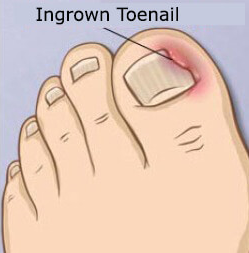Ingrown toenails develop when the edge or corner of your toenail grows into the surrounding skin. This condition commonly affects the big toe and may lead to discomfort or infection. Though often a minor issue, untreated ingrown toenails can worsen and lead to complications. Understanding the causes, symptoms, and treatment options can help address the condition early and avoid further issues.
What Is an Ingrown Toenail?
An ingrown toenail occurs when the side of a toenail grows into the soft tissue surrounding it. This growth irritates the skin, causing pain and inflammation. Left unmanaged, it can progress to infection, which may lead to more severe discomfort or drainage from the affected area. Ingrown toenails most frequently affect the big toe due to its size and the pressure it often endures during activities like walking or wearing tight footwear.
What Causes It?
This condition may result from several factors. Improper nail trimming is one of the most common causes, particularly if nails are cut too short or rounded at the edges. This can encourage the nail to grow into the skin instead of straight outward.
Tight-fitting shoes and socks may also play a role. Consistent pressure on the toes from poorly fitted footwear increases the risk of the nail pressing into and injuring the surrounding skin. Other contributors include toe injuries, fungal infections, or naturally curved nails that are more prone to growing into the skin.
What Are the Symptoms?
Symptoms usually begin with tenderness along the edge of the toenail. The area may appear red or swollen and feel painful to the touch. Individuals may notice discomfort when wearing shoes or walking, particularly if the shoe rubs against the affected area. If the ingrown nail becomes infected, symptoms may progress to increased swelling, throbbing pain, or discharge of pus.
What Are the Available Treatment Options?
A variety of treatment options are available to address ingrown toenails. Treatments range from simple home remedies to more advanced medical interventions. Taking action early helps resolve the problem without the need for invasive measures.
Home treatments
- Over-the-counter anti-inflammatory medications can help reduce swelling and ease discomfort.
- Soaking the affected foot in warm water multiple times a day can soften the skin and nail, making the area easier to treat.
- Avoid wearing tight shoes and socks to reduce pressure on the toe and allow it to heal naturally.
Medical treatments
If home treatments do not alleviate symptoms, medical options may be necessary. For an infection, a healthcare provider prescribes antibiotics. For more severe cases, partial removal of the toenail may be required. During this procedure, a doctor numbs the area and removes the portion of the nail causing the problem.
Why Does Early Intervention Matter?
Addressing an ingrown toenail early can prevent it from worsening. Mild cases are often manageable at home and less likely to progress to more painful or infected stages. Early intervention also decreases the likelihood of needing medical or surgical treatment. Timely treatment not only limits discomfort but also preserves foot health and function, reducing interruptions to daily life.
See a Podiatrist Today
An ingrown toenail can start with minor symptoms but may escalate into a more serious problem if left untreated. Recognizing the symptoms and exploring early management options can help avoid unnecessary pain or complications. Consult a podiatrist for personalized advice and professional care. Protect your foot health by seeking expert help sooner rather than later.


Leave a Reply